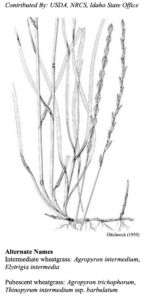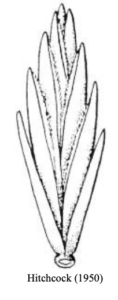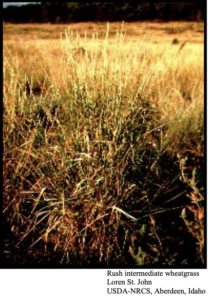hinopyrum intermedium
(Host) Barkworth & D.R. Dewey
plant symbol = THIN6

Uses
Grazing/pastureland/hayland: This is an introduced species used for hay and pasture in the northern Great Plains, west to central Washington, and south into Colorado, Kansas, and northern New Mexico and Arizona.
It produces good hay yields, both in monoculture and in mixtures with alfalfa (Medicago spp.), where its stiff stems tend to keep alfalfa from lodging.
Intermediate wheatgrass has fairly slow re-growth following clipping and is best adapted to single crophaying situations (where rainfall patterns or limited irrigation prevents multiple cuttings in a season). Intermediate wheatgrass responds very well to irrigation with initial production nearing the level of orchardgrass (Dactylis glomerata) and meadow brome (Bromus biebersteinii) and exceeding smooth brome (Bromus inermis) under full irrigation. Meadow brome and orchardgrass have much better regrowth characteristics and will normally produce more than intermediate wheatgrass for hay production in multiple cutting situations.
Intermediate wheatgrass responds very well to limited irrigation. It is able to tolerate droughty conditions when irrigation ceases as long as about 12-14 inches or more total annual moisture is provided. It provides excellent spring, early summer, and fall pasture, but must be carefully managed to ensure maintenance of the stand and high production.
Intermediate wheatgrass is palatable to all classes of livestock and wildlife. It is a preferred feed for cattle, sheep, horses, deer, antelope, and elk in spring, early summer and fall. It is considered a desirable feed for cattle, sheep, horses, and elk in summer and winter.
Erosion control/reclamation: Intermediate wheatgrass is well adapted to the stabilization of disturbed soils. This grass can be used in critical and urban areas where irrigation water is limited and to stabilize ditchbanks, dikes, and roadsides. This grass can also be use to build soils because of its heavy root production. Levels as high as 7000 pounds (dry weight) per acre of root production in the upper 8 inches of soil have been measured in five-year-old stands.
Wildlife: Strips of intermediate wheatgrass left ungrazed provide good nesting cover for game birds and migratory waterfowl.
Status
Consult the PLANTS Web site and your State Department of Natural Resources for status, such as state noxious status and wetland indicator values.
Description
General: Grass Family (Poaceae). As one of the common names implies, the spikes, spikelets, glumes, lemmas, and leaves of what once was considered pubescent wheatgrass are densely covered with hairs, whereas intermediate wheatgrass has vegetative structures which are for the most part smooth, but may have ciliate hairs on the leaf margins. The previously recognized separate species of intermediate and pubescent wheatgrass are now recognized as one species, Thinopyrum intermedium.
Intermediate wheatgrass grows to 3 to 4 feet tall. It is a long-lived, cool season grass with short rhizomes and a deep feeding root system. The seed spikes may be up to 4 to 8 inches long. Leaves are 4-8 mm wide and green to blue-green in color and sometimes drooping. The lemmas, paleas, and glumes are smooth to pubescent. The glumes are acute to blunt, generally five nerved, and awnless to awn tipped. There are usually fewer than seven florets. Commercial seed of Intermediate wheatgrass often contains both pubescent and glabrous forms.
Distribution
Intermediate wheatgrass is a perennial grass introduced in 1932 from Europe and Asia. Included in this group is a form that was known as pubescent wheatgrass (Agropyron trichophorum), which was introduced in 1934 from Europe and Asia and considered slightly more drought tolerant and winter hardy. For current U.S. distribution, please consult the Plant Profile page for this species on the PLANTS Web site.

Adaptation
Intermediate wheatgrass is adapted to areas with 12 to 14 inches of annual rainfall or greater. The pubescent form can tolerate slightly more droughty conditions to 11 or 12 inches of rainfall. It performs best between 3500 and 9000 feet elevation. It can be seeded at lower elevations, but moisture requirements are greater. It is not as drought tolerant as crested wheatgrass (Agropyron desertorum and A. cristatum), Siberian wheatgrass (Agropyron fragile) or Russian wildrye (Psathyrostachys juncea).
The glabrous form of Intermediate wheatgrass prefers well drained loamy to clayey textured soils. It will tolerate slightly acidic to mildly saline conditions, is cold tolerant, can withstand moderate periodic flooding in the spring, and is very tolerant of fire. The pubescent form performs best on loamy to sandy to shallow soils and can tolerate lower fertility, more alkaline soils, higher elevations, and drier conditions than the glabrous form. It performs poorly on wet, poorly drained, and moderately saline to alkaline soils with prolonged inundation.
Establishment
Planting: It should be seeded with a drill at a depth of 1/2 inch or less on medium to fine textured soils and no more than 1 inch deep on coarse textured soils. Recommended seeding rate is 8 pounds Pure Live Seed (PLS) per acre or 15 PLS seeds per square foot.
A firm weed free seedbed enhances stand establishment. It is compatible with other species, particularly alfalfa (Medicago spp.). In a mixture with alfalfa, stand longevity and productivity is often enhanced. If used as a component of a mix, adjust seeding rates to percent of mix desired. The best dryland results are obtained from seeding in very early spring on heavy to medium textured soils and in late fall (dormant) on medium to light textured soils. Irrigated lands should be seeded in spring through summer. Late summer (August – mid September) seedings are not recommended unless irrigation is available.
For mine lands, roadsides, and other harsh critical areas, the seeding rate should be increased to 16 pounds PLS per acre or 30 PLS seeds per square foot.
Intermediate wheatgrass establishes fairly quickly. Establishment is quicker than meadow brome or smooth brome varieties. Seedling vigor is good to excellent. Under favorable conditions intermediate wheatgrass provides good weed suppression. It makes good spring growth, fair summer growth, and good fall growth, if moisture is available. Light, frequent irrigation is beneficial for stand establishment.
Protect a new seeding until it is fully established and the plants are able to withstand pulling by grazing animals without being uprooted. It is beneficial to cut at least one hay crop prior to grazing.
Stands may require weed control measures during establishment. Application of 2,4-D should not be made until plants have reached the four to six leaf stage (be sure to read and follow label directions). Mow weeds at or prior to their bloom stage. Grasshoppers and other insects may also damage new stands and pesticides may be needed for control.
Management
Intermediate wheatgrass is highly palatable to livestock and wildlife. Livestock and wildlife will graze it throughout the growing season, but it is most preferred as forage in spring, early summer, and fall. A healthy, productive stand will not withstand heavy continuous grazing. Stands of intermediate wheatgrass are not as susceptible to spring and fall freezing as smooth brome, meadow brome, or orchardgrass.

Ten to twelve inches of new growth should be attained in spring before grazing is allowed on established stands. A six-inch stubble height should be maintained following grazing or mowing and going into winter. In pasture tests, stands consistently out-yield other grass-legume mixtures. For this reason, stocking rates can be set higher than other grasses. Care should be taken to allow proper rest of at least 21 to 28 days between grazing periods under irrigated and high moisture situations. When planted with a legume, harvest hay at optimum stage for the legume. This will allow the grass to be harvested prior to flowering and result in very high quality hay. Harvest pure stands of intermediate wheatgrass for hay when plants start to flower.
Apply nitrogen as needed to maintain vigorous growth. Irrigated seedings and those in higher rainfall zones (18 inches +) will respond well to annual applications of 40 or more pounds of available nitrogen per acre during the establishment year and 70 to 90 pounds per acre each fall after establishment. A balance of nitrogen and phosphate fertilizer needs to be considered in order to maintain a legume component in a mixture. A soil test is recommended.
Forage production can be restored and stands may benefit from ripping if sodbound conditions occur. Care should be taken to avoid excessive tillage because stands may be damaged.
Environmental Concerns
Intermediate is long-lived (50+ years), spreads slowly vegetatively, and very little via seed distribution. It is not considered a “weedy” or invasive species, but can spread into adjoining vegetative communities under ideal climatic and environmental conditions. Research indicates that most seedings do not spread from original planting sites. It is known to coexist with native plants. On favorable sites where it is best adapted, it can maintain dominance and exist as a monoculture. There is no documentation that it crosses with native species.
Seed Production
Seed production of intermediate wheatgrass is generally not difficult. If fields are maintained in rows and adequate fertility levels are maintained, seed can be produced for 7 to 10 years. Row spacing of 36 inches dryland (areas with a minimum of 14 inches annual precipitation) and 24 to 36 inches irrigated are recommended. Intermediate wheatgrass is rhizomatous and to maintain seed production it should be maintained in row culture. Cultivation is required to maintain rows.
Average production of 250 to 350 pounds per acre can be expected under dryland conditions. Average production of 450 to 550 pounds per acre can be expected under irrigated conditions. Seed yields drop significantly after about four years of production. Harvesting is best completed by swathing, followed by combining of the cured rows. The seed heads will shatter when mature and if direct combining is desired the stand should be harvested when the top of seed heads just begin to shatter. Harvested seed must be dried to 12 percent moisture before storing in bins and to 15 percent before storing in sacks. Seed is generally harvested in mid to late August.
Cultivars, Improved and Selected Materials (and area of origin)
Certified seed of many cultivars in the following discussion are available through the appropriate state Crop Improvement Associations or from commercial sources.
‘Amur’ intermediate wheatgrass was selected from seed originally obtained from China by the Pullman PMC and transferred to the Los Lunas PMC, New Mexico and released by the PMC, New Mexico AES and University Park in 1952. It was selected for leafiness, vigorous growth, strong seedling vigor, and good seed production. It is a slow sod former. It was originally released for revegetation of disturbed lands and for pasture seedings at higher elevations. Introgression has occurred resulting in a high percentage of pubescent types over the years. Certified seed stock is no longer available. It has been replaced by other varieties, which are more widely adapted and/or better producers. It is not readily utilized in the northern U.S.
‘Chief’ intermediate wheatgrass was selected from seed originating in Russia by the Agriculture Canada Research Station in Saskatoon, Saskatchewan and was released in 1961. It was selected for high seed yield and forage quality. Its intended uses are as a grass component in grass-alfalfa hay mixtures and for short-term pasture that remains productive for about five years under heavy grazing pressure. Certified seed is available and Agriculture Canada maintains Breeder seed.
‘Clarke’ intermediate wheatgrass was selected from seed originating in Russia by the Agriculture Canada Research Station and was released in 1980. It was selected for drought tolerance, winter hardiness and high seed yields. It’s intended uses are for hay and pasture either dryland or irrigated in the northern Great Plains of Canada and the U.S. Certified seed is available and Agriculture Canada maintains Breeder seed.
‘Greenar’ intermediate wheatgrass was selected from seed originating in Russia by Pullman PMC and was released by Idaho-Oregon-Washington AES and the PMC as P-2327 in 1945. Aberdeen and Pullman Plant Materials Centers named it in 1956. It was selected for vigor, moderate sod formation, leafy, broad-leafed, late maturing, and high production. Its intended use is for hay and pasture. Certified seed is no longer available.
‘Greenleaf’ pubescent wheatgrass was selected from seed originating from unknown European or Asian sources. Commercial seed sources in Washington and North Dakota were utilized by the Agriculture Canada Research Station to develop this cultivar and it was released in 1966. It has higher forage yields than ‘Topar’ and improved seedling vigor over ‘Mandan 759’. It was intended for use as a winter hardy plant for pasture and hay production. Stands will not maintain high productivity under continuous heavy grazing. Certified seed is available and Agriculture Canada maintains Breeder seed.
‘Luna’ pubescent wheatgrass was selected from seed originating in Russia and Turkey by the Los Lunas PMC and was released by the New Mexico AES and PMC in 1963. It was selected for excellent seedling vigor, fast establishment and good forage production. Luna is one of the most broadly adapted pubescent wheatgrasses available and performs well from the central to northern Great Plains to the northern Rockies and Sierra Nevada regions. Certified seed is available and Breeder seed is maintained by the Meeker PMC.
‘Manska’ pubescent wheatgrass was selected from seed originating in Russia by the Great Plains Research Laboratory. It traces to 11 separate commercial lots of ‘Mandan 759’ intermediate wheatgrass (no longer available). It was selected for improved vigor, resistance to leaf spot, high forage and seed production, and nutritional quality. High nutritional value is the primary advantage of ‘Manska’ over other pubescent wheatgrass cultivars. ARS, Bismarck PMC, University of Nebraska and North Dakota AES, released it in 1992. It is intended for use in grass alfalfa hay mixes and for pasture. Certified seed is available and the Great Plains Research Laboratory maintains Breeder seed.
‘Oahe’ intermediate wheatgrass was selected from seed originating in Russia by South Dakota AES, Brookings, South Dakota and was released in 1961. Named after the Oahe Dam on the Missouri River, it is an abbreviation for the Sioux word meaning “Big House.” It was selected for its uniformly bluish green color, drought tolerance, vigor, rhizomatous traits and high seed yields. Oahe is adapted for hay, pasture and conservation purposes. Certified seed is available and South Dakota State University maintains Breeder seed.
‘Reliant’ intermediate wheatgrass was selected from sources adapted to the Northern Great Plains region. It was developed by the Northern Great Plains Research Laboratory and released by ARS, North Dakota AES and Bismarck PMC in 1991. It was selected for resistance to leaf spot, improved vigor, forage, seed production, forage quality and winter survival. It is of medium height, late maturing and adapted for hay, pasture and conservation purposes. Persistence and sustained productivity under hayland management in mixes with alfalfa are the primary advantages of ‘Reliant’ over other intermediate wheatgrass cultivars. Certified seed is available and the Great Plains Research Laboratory maintains Breeder seed.
‘Rush’ intermediate wheatgrass was selected from seed originating from sources in Germany. It was selected by the Aberdeen PMC and released by the Idaho AES and Aberdeen PMC in 1994. It was selected for superior seedling emergence and vigor compared to other intermediate wheatgrasses, good spring recovery, good rate of spread by rhizomes, uniform seedheads, wide leaves, high forage production, and high seed production. It has the largest seed of intermediate wheatgrasses, averaging 66,000 seeds per pound. It is adapted for soil erosion control, roadside stabilization, mine spoil stabilization, hayland, and pastureland both dry and irrigated, and forage for livestock and wildlife. It is not adapted to hay mixtures with alfalfa. Certified seed is available and Breeder seed is maintained by Aberdeen PMC.
‘Slate’ intermediate wheatgrass was selected from seed originating from a derivative of ‘Amur’ and another experimental accession. It was developed by the Nebraska AES and ARS and was released in 1969. It was selected for strong rhizomatous spread, erect form, broad flat leaves, and slate green color. It is adapted for use in the central Great Plains region. Certified seed is available and Breeder seed is maintained by Nebraska AES and ARS.
‘Tegmar’ intermediate wheatgrass was selected from seed originating in Turkey. It was developed by Pullman PMC and was released by IdahoWashington AES and Aberdeen and Pullman PMCs in 1968. It was selected for long life, late maturing, vigorous seedlings, rapidly developing rhizomes, drought tolerance and dwarf growth form. It is generally about half the height of other intermediate wheatgrasses. Intended for use in erosion control, roadside and ditch stabilization, dam stabilization and grassed waterways. Certified seed is available and Breeder seed is maintained by Aberdeen PMC.
